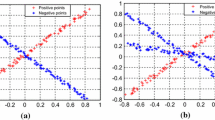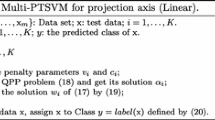Abstract
In this paper, a novel binary classifier termed as GPTSVM (projection twin support vector machine via Geometric Interpretation) is presented. In the spirit of original PTSVM, GPTSVM tries to seek two projection axes, one for each class, such that the projected samples of one class are well separated from that of the other class along its own projection axis. A pair of parameters (ν) are introduced in GPTSVM to control the bounds of the fractions of the support vectors and the error margins. Moreover, GPTSVM can be interpreted as a pair of minimum Mahalanobis norm problems on two reduced convex hulls (RCHs). Then, an efficient geometric algorithm for GPTSVM is presented based on the well-known Gilbert’s algorithm. By doing so, the dual problem of GPTSVM can be solved very fast without resorting to any specialized optimization toolbox. The experimental results on several UCI benchmark data sets, traffic accident prediction data, and large scale NDCC database show the feasibility and effectiveness of the proposed algorithm.






Similar content being viewed by others
References
Bishop C (2006) Pattern recognition and machine learning. Springer, New York
Boyd S, Vandenberghe L (2004) Convex optimization. Cambridge Univ Pr, Cambridge
Chen X, Yang J, Ye Q, Liang J (2011) Recursive projection twin support vector machine via within-class variance minimization. Pattern Recogn 44:2643–2655
Chen X, Cai X, Liang J, Liu Q (2018) Ensemble learning multiple LSSVR with improved harmony search algorithm for short-term traffic flow forecasting. IEEE Access 6:9347–9357
Cortes V, Vapnik V (1995) Support-vector networks. Mach Learn 20(3):273–297
Ding SF, Yu JZ, Qi BG, Huang HJ (2014) An overview on twin support vector machines. Artif Intell Rev 42(2):245–252
Franc V, Hlavac V (2003) An iterative algorithm learning the maximal margin classifier. Pattern Recogn 36:1985–1996
Fu Z, Robles-Kelly A, Zhou J (2010) Mixing linear SVMs for nonlinear classification. IEEE Trans Neural Netw 21:1963–1975
Gao B, Wang J (2019) A fast and robust TSVM for pattern classification https://arxiv.org/pdf/1711.05406.pdf
Gilbert EG (1966) An iterative procedure for computing the minimum of a quadratic form on a convex set. SIAM J Control 4:61–79
Hua X, Ding S (2015) Weighted least squares projection twin support vector machines with local information. Neurocomputing 160:228–237
Hua X, Xu S, Gao J, Ding S (2019) L1-norm loss-based projection twin support vector machine for binary classification. Soft Comput 23(21):10649–10659
Jayadeva KR, Chandra S (2007) Twin Support Vector Machines for pattern classification. IEEE Trans Pattern Anal Mach Intell 29:905–910
Krizhevsky A, Sutskever I, Hinton G (2010) Imagenet classification with deep convolutional neural networks. Adv Neural Inf Process Syst 1097–1105
LeCun Y, Bengio Y, Hinton G (2015) Deep learning. Nature 521(7553):436–444
Li K, Cheng GY, Sun XD, Yang ZB (2019) A nonlinear flux linkage model for bearingless induction motor based on GWO-LSSVM. IEEE Access 7:36558–36567
Mangasarian OL, Wild EW (2006) Multisurface proximal support vector machine classification via generalized eigenvalues. IEEE Trans Pattern Anal Mach Intell 28:69–74
Mavroforakis ME, Theodoridis S (2006) A geometric approach to support vector machine (SVM) classification. IEEE Trans Neural Netw 17:671–682
Mir A, Nasiri J (2018) KNN-based least squares twin support vector machine for pattern classification. Appl Intell 48(12):4551–4564
Musicant D (1998) NDC: normally distributed clustered datasets. Computer Sciences Department, University of Wisconsin, Madison
Peng X, v-Twin A (2010) Support vector machine (ν-TSVM) classifier and its geometric algorithms. Inf Sci 180:3863–3875
Qian D, Wang B, Qing XG, Zhang T, Zhang Y, Wang XG (2017) Masatoshi Nakamura: Drowsiness Detection by Bayesian-Copula Discriminant Classifier Based on EEG Signals During Daytime Short Nap. IEEE Trans Biomed Eng 64(4):743–754
Schölkopf B, Smola A, Williamson R, Bartlett P (2000) New support vector algorithms. Neural Comput 12:1207–1245
Shao Y, Chen W, Wang Z (2015) Weighted linear loss twin support vector machine for large-scale classification. Knowl-Based Syst 73:276–288
Sun XD, Zhu HQ, Yang ZB (2013) Application of LSSVM inverse in a variable frequency induction motor drive system. Trans Inst Meas Control 37(6):826–840
Sun XD, Su BK, Chen L, Yang ZB, Chen JF, Zhang WY (2016) Nonlinearflux linkage modeling of a bearingless permanent magnet synchronous motor based on AW-LSSVM regression algorithm. Appl Electromagn Mech 51(2):151–159
Tanveer M, Khan MA, Ho SS (2016) Robust energy-based least squares twin support vector machines. Appl Intell 45(1):174–186
Tao Q, Wu G, Wang J (2004) A generalized SK algorithm for learning ν-SVM classifiers. Pattern Recogn Lett 25:1165–1171
Tomar D, Agarwal S (2015) Twin support vector machine: a review from 2007 to 2014. Egypt Inf J 16(1):55–69
Vapnik VN (1995) The nature of statistical learning theory. Springer-Verlag, New York
Vapnik VN (1998) Statistical learning theory, New York, Wiley
Xiang C, Fan X, Lee T (2006) Face recognition using recursive fisher linear discriminant. IEEE Trans Image Process 8:2097–2105
Xiong X, Chen L, Liang J (2018) A new framework of vehicle collision prediction by combining SVM and HMM. IEEE Trans Intell Transp Syst 19(3):699–710
Xiong XX, Chen L, Liang J (2018) Analysis of roadway traffic accidents based on rough sets and bayesian networks. Promet – Traffic Transp 30(1):71–81
Xu Y, Yang Z, Pan X (2017) A novel twin support-vector machine with pinball loss. IEEE Trans Neural Netw Learn Syst 28(2):359–370
Yan H, Ye Q, Zhang T (2018) Least squares twin bounded support vector machines based on L1-norm distance metric for classification. Pattern Recogn 74:434–447
Yan H, Ye Q, Zhang T, Yu D, Xu Y (2018) L1-Norm GEPSVM classifier based on an effective iterative algorithm for classification. Neural Process Lett 48(1):273–298
Yang LY, Dong YN, Tian W, Wang ZJ (2019) The study of new features for video traffic classification. Multimed Tools Appl 78(12):15839–15859
Ye Q, Zhao C, Ye N, Chen Y (2010) Multi-weight vector projection support vector machines. Pattern Recogn Lett 31:2006–2011
Zhang Y, Zhang H, Chen X, Lee SW, Shen D (2017) Hybrid high-order functional connectivity networks using resting-state functional MRI for mild cognitive impairment diagnosis. Sci Rep 7(1):6530
Zhang Y, Zhang H, Chen X, Liu M, Zhu X, Lee SW, Shen D (2019) Strength and similarity guided group-level brain functional network construction for MCI diagnosis. Pattern Recogn 88:421–430
Zhou T, Liu MX, Thung KH, Shen DG (2019) Latent representation learning for alzheimer's disease diagnosis with incomplete multi-modality neuroimaging and genetic data. IEEE Trans Med Imaging 38(10):2411–2422
Zhou T, Thung KH, Liu MX, Shi F, Zhang CQ, Shen DG (2020) Multi-modal latent space inducing ensemble SVM classifier for early dementia diagnosiswith neuroimaging data. Med Image Anal 60:101630
Acknowledgements
The authors would like to thank the anonymous reviewers for their constructive comments and suggestions. This work was partially supported by the National Key Research and Development Program of China (2018YFB0105000), National Science Foundation of China (61773184, 51875255, 6187444, U1664258, U1762264, 61601203), Six talent peaks project of Jiangsu Province (Grant No. 2017-JXQC-007).
Author information
Authors and Affiliations
Corresponding author
Additional information
Publisher’s note
Springer Nature remains neutral with regard to jurisdictional claims in published maps and institutional affiliations.
Rights and permissions
About this article
Cite this article
Chen, X., Xiao, Y. Geometric projection twin support vector machine for pattern classification. Multimed Tools Appl 80, 23073–23089 (2021). https://doi.org/10.1007/s11042-020-09103-1
Received:
Revised:
Accepted:
Published:
Issue Date:
DOI: https://doi.org/10.1007/s11042-020-09103-1




